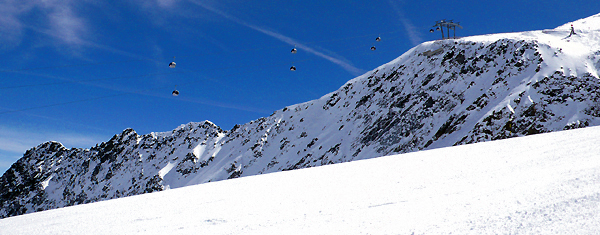Good to know
Building and planning permission is not only necessary if cableway facilities are being newly constructed, but also for changes to the infrastructure, to subsystems and to safety components. After construction or conversion work, an operating licence must be obtained confirming that there are no reservations regarding the safety and order of the cableway operation and cableway traffic.

The Federal Ministry for Climate Action, Environment, Energy, Mobility, Innovation and Technology (BMK) is Austria’s supreme cableway authority. This task comes with great responsibility – domestic cableway transport looks back on decades of tradition. An aerial lift to the Rax was put into operation as early as 1926, and the first chairlift was built in Wildschönau in 1947. Since the very beginning, the focus has been on quality, safety and comfort in the industry.
Today, the cableway industry is an indispensable economic factor in Austria. Development of the mountains is of huge importance for both winter and summer tourism. Almost 3,000 cableway installations already transport around 600 million passengers every year. The annual cash turnover of the cableway industry is considerably more than one billion euros. An investment volume of around 600 million euros makes an important contribution to regional added value. In addition, Austria’s cableways help to safeguard jobs in rural areas.
Cableways are one of the safest means of mass transportation as a result of the strict safety standards. The cableway staff have to check certain parts on a daily basis. In addition to further weekly, monthly and annual inspections, cableways must also be examined comprehensively every five years by special experts. The overwhelming majority of accidents is not traced back to technical causes, but rather to passenger misconduct. It is therefore all the more important to follow certain rules: Comply with the instructions of the staff, do not ski slalom on tow lifts, close chairlifts properly and do not open them too early, do not push at the entry, pay particular attention to children and do not, under any circumstances, use lift facilities while under the influence of alcohol.
A strict system of reporting obligations ensures that a complete record is made of all incidents. The BMK advocates for the high quality and safety standards in a variety of national and international cableway bodies, including at a European level.
Rules for the construction and operation of cableways
Anyone who wishes to construct and operate a public cableway requires an official permit. In this regard, the public benefit of this cableway is determined. Depending on the competence, the temporary licence is granted by the Federal Minister for Climate Action, Environment, Energy, Mobility, Innovation and Technology, or by the respective state governor. Building and planning permission is not only necessary if cableway facilities are being newly constructed, but also for changes to the infrastructure, to subsystems and to safety components. After construction or conversion work, an operating licence must be obtained confirming that there are no reservations regarding the safety and order of the cableway operation and cableway traffic.
Types of cableways
The Austrian Cableway Act (Seilbahngesetz) distinguishes between many different systems. On a "funicular railway", the carriages are moved on a cable or several cables along a track that is located on the ground or is supported by fixed structures. Austria’s first funicular railway led up to Hohensalzburg Fortress as early as 1892. On an "aerial lift", on the other hand, the cabins are carried by a cable or several cables without fixed guides. "Cable car" is the term for special aerial lifts on which the cabins run in shuttle operation between stations. A "gondola lift" is also an aerial lift, on which the cabins are always moved in the same direction. Further differentiations are made here between cabin lifts, detachable chairlifts, fixed-grip chairlifts and combination lifts with cabins and chairs. The first combination lift was built in Abtenau in 2005. Last but not least, there are also tow lifts, a type of cableway on which people on skis or other suitable sports equipment are transported using a towing device on a tow track.
The BMK is responsible for funicular railways, cable cars, cabin lifts, combination lifts and for licence and building and planning permission procedures for detachable chairlifts. The state governors are the authority for detachable chairlifts, fixed-grip chairlifts, combination lifts and non-public cableways. Further important contacts are the Trade Association of Austrian Cableways and the Labour Inspectorate for Transport at the Federal Ministry of Labour.